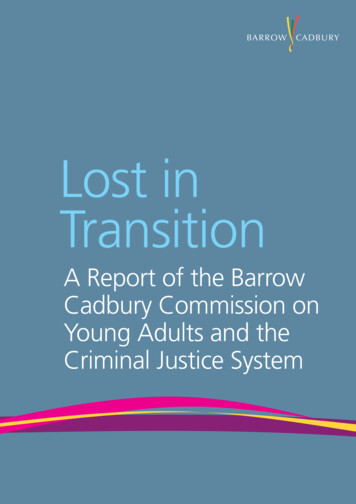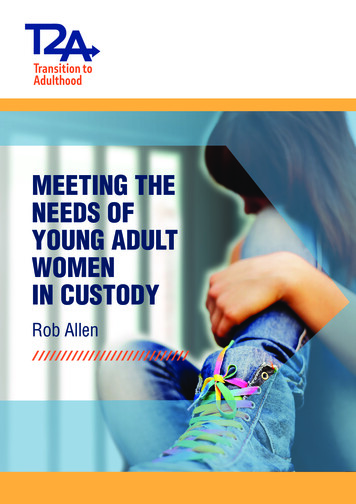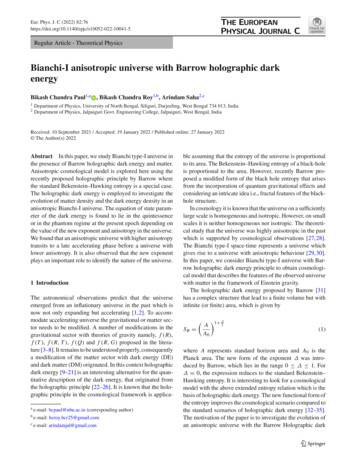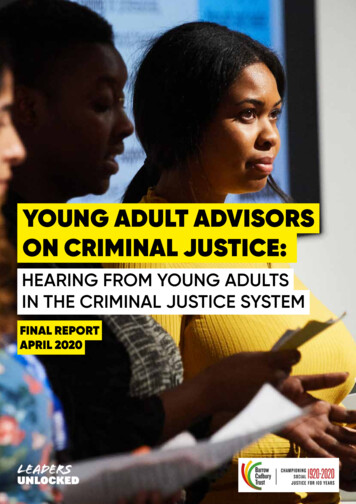
Transcription
Lost inTransitionA Report of the BarrowCadbury Commission onYoung Adults and theCriminal Justice System
ContentsFurther copies of the report are available from:2Membership of the Commission3Foreword by Sukhvinder Stubbs,Director, Barrow Cadbury Trust4About the Commission on Young Adults and theCriminal Justice System5Introduction by Greg Parston, Chair of the Commission6A Life of Byron9Pathways to adulthood and the criminal justice system151. Developing a criminal justice model for youngadults in transition252. Sentencing young adults on age and maturity333. Policing young adults374. Improving mental health care for young adults415. Improving the treatment of young adults withsubstance and alcohol problems456. Education, employment and training and young adults517. Housing young adults558. Health and social care for young adults599. Measuring social outcomes in the criminaljustice system62Summary of Recommendations64Notes65Annex: Organisations consultedBarrow Cadbury Trust25–31 Tavistock PlaceLondon WC1H 9SFT 020 7391 9220F 020 7391 9229www.barrowcadbury.org.ukThe report is also available in Welsh.Please note that the young adults pictured in this report have been included for illustrative purposesand are not connected to any of the individuals that are quoted or referred to throughout the report.1
Membership ofthe CommissionForewordChair of the CommissionI am delighted to introduce the report from the Commission on Young Adults andthe Criminal Justice System. Barrow Cadbury have had a longstanding commitmentto penal reform. From founding the Cropwood Fellowships at the Cambridge Institute ofCriminology to supporting the All Party Penal Affairs Group and Penal Affairs Consortium,we have also developed lasting partnerships with key organisations in the sector suchas the Prison Reform Trust and Nacro.Greg Parston, Executive Chair of the Office for Public ManagementCommission MembersSheila Adam, Director of Public Health at North East London Strategic Health AuthorityMark Ashford, Taylor Nichol SolicitorsCarol Bernard CBE, Director of Offender Management Service, WalesProfessor John Bynner, Director of the Centre for Research on the Wider Benefits of Learning,Institute of Education, University of LondonJane Drabble OBE, Chair of Mental Health Media, Member of the National Learning and Skills Counciland former Director of Education at the BBCMarc Edwards, Director, The Young DisciplesUna Padel OBE, Director, Centre for Crime and Justice Studies, Kings College, University of LondonSir Charles Pollard, Youth Justice Board, Chair of the Justice Research Consortium and formerChief Constable, Thames Valley PoliceProfessor David Smith, Professor of Criminology, Lancaster UniversityAnna Southall, Chair of the Barrow Cadbury TrustProfessor Michael Tonry, Marvin J. Sonosky Professor of Law and Public Policy, University of MinnesotaEd Williams, Managing Director, Hanover Partnership and former Head of Corporate Social Responsibility,Marks & SpencerSecretary and Senior Researcher to the CommissionKatharine Jones, Secretary and Senior Researcher to the Commission (from November 2004)Barry Mussenden Secretary to the Commission (to November 2004)Research and Support TeamDan Burn, Researcher, Office for Public Management (to October 2004)Rebecca Korda, Administrator, Barrow Cadbury Trust (to February 2005)Alice Murray, Administrator and Research Assistant, Barrow Cadbury Trust (from February 2005)Susan Watson, Researcher, Barrow Cadbury Trust (to February 2005)Sharon Wellington, Senior Administrator, Barrow Cadbury Trust2The gap in meeting the needs of young people who are makingthe transition to adulthood emerged as a central concern for thegroups we support. In particular the criminal justice system whichchooses to demarcate a young person from an adult at the arbitraryage of 18 has emerged as one of the starkest examples of wherevulnerable young people are being failed. Given that almost 10 percent of young people aged between 18 and 24 have been cautionedor arrested by the police, this is a key omission in policy. To themany communities that Barrow Cadbury supports the links betweengrowing up in poverty and the routes into crime are clear. Criticallyfor Barrow Cadbury and for many of our communities the overrepresentation of African Caribbean young men, and increasinglyMuslim young men in the criminal justice system signifies the needfor an overhaul of a system which so clearly puts criminal justicebefore social justice in the pathway to adulthood.I would like to take this opportunity to thank the Commissioners forthe time, effort and passion they contributed so freely and especiallythe Chair, Greg Parston who has consistently provided great insightand vision throughout.Forming a Commission was an appropriate way to highlightand develop innovative and workable solutions to the problemsthat young adults face in growing up in the criminal justicesystem. The report which has emerged from our distinguishedgroup of Commissioners emphasises the devastating impact thatimprisonment has on a young person’s life chances and the futilityof a criminal justice system that sees nearly three quarters of 18 – 20year olds reconvicted after release from the prison system.Sukhvinder StubbsDirector, Barrow Cadbury TrustSeptember 2005Barrow Cadbury will respond to the recommendations of theCommission by reforming our funding programme in a way whichpromotes the improvement of life chances of young people whoare caught up in the criminal justice system. New funding guidelineswill be launched in spring 2006. We will also look to build uppartnerships with organisations interested in building wider publicsupport to ensure that young adults are given the support and helpthat they need.3
About the CommissionIntroductionThe independent Commission on Young Adults and the Criminal Justice System wasestablished by the Barrow Cadbury Trust. The role of the Commission was to develop a wayin which the criminal justice system can recognise the importance of the transition betweenadolescence and adulthood, to develop ideas about how the system can promote naturaldesistance from offending in young adults in transition, and to find a way in which thecriminal justice system could better promote the life chances of young adults.The Commission began its work in summer 2004. A wide range of stakeholders wereinvited to submit written evidence or were consulted through one-to-one or roundtablediscussions about the issues facing young adults in transition and what the solutionscould be. A list of organisations consulted is appended to the report. Commissioners alsomade a number of study visits to projects aimed at helping young adults in transition, inthe UK, in Europe and in North America. The recommendations contained in the reporthave been informed by the consultations and the visits.A number of partner organisations undertook a range of projects for the Commissionto help develop the recommendations and the report:a) The Prison Reform Trust in partnership with Jane Gordonexamined potential proposals for sentencing young adultsin the courts;b) MEL Regeneration facilitated a number of focus groups withyoung adults across England and Wales;c) The Social Market Foundation examined and evaluated privatesector employment schemes for young adults in custody andin the community;d) Crime Concern reviewed the extent of provision for young adultsin the voluntary and community sector in two case study areas– the West Midlands and South West;e) The National Association for the Care and Resettlement ofOffenders (Nacro) facilitated pilot discussion groups betweencommunity police and young adults, and hosted a roundtablediscussion on the housing issues facing young adults;f) Dr Colin Webster, Dr Rob MacDonald, Tracey Shildrick, and MarkSimpson of Teesside University undertook a literature review onthe theme of young adults, social exclusion and the extendedtransition to adulthood;h) Professor Roger Bowles and Rimawan Pradiptyo of the Centrefor Criminal Justice, Economics and Psychology, University of Yorkundertook an analysis of the cost and benefit considerations ofyoung adults in the criminal justice system. The findings from thiswork will be available as a supplementary report.Further information about the work of the Commission, andreports from some of the studies listed above, will be availableat www.barrowcadbury.org.uk.Thank you to all the young adults who gave up their time to tell usabout their experiences, Gary Younge who helped us write aboutthe messages from the young people, Rob Blackhurst for helpingto finalise the report and Jason Wilde for the photography.Young people grow up, most into civilly responsible adults, but some encounter troublealong the way. Trouble can stem from a number of factors, including social and economicdeprivation and discrimination. Yet, when young people in trouble engage public services,including those of the criminal justice system, that are intended to help them developand grow into responsible adults, they can find the experience frustrating, unhelpfuland even damaging.Part of the reason for that is that public services are not gearedas well as they could be to help young people – particularlyyoung people in trouble – make the transition to adulthood. Theconsequence is that many of those people get lost in transition.That is not good for them, and ultimately not good for any of us.The Barrow Cadbury Trust’s Commission on Young Adults andthe Criminal Justice System has tried to address this issue directly:how can criminal justice services, and public services in general,work more effectively to help young people to lead crime-freelives and to develop into fulfilled adults? The challenges here areimmense, demanding a careful balancing of individual and societalinterests, of focus on criminal behaviour and the causes of criminalbehaviour, of the capacities of the criminal justice system and theappropriateness of other social justice interventions. I believe thatthe recommendations that the Commission has fashioned can goa long way in striking those balances.I am very pleased to have been able to participate in this work andin the learning and critical constructions that the Commission haveundertaken in order to produce this report. My personal thanksgo to the Commission members, each of whom put in more time,effort and commitment than they were asked to do when westarted, and to the Barrow Cadbury Trust research team and staffwho worked so hard to make our work seem so painless. Finally,I would like to acknowledge and thank all those who work withyoung people in transition who shared with us their successes andfailures so that we could learn more, and especially the youngpeople themselves who contributed their own experiences andknowledge to our work.Greg Parston, PhDChair of the CommissionSeptember 2005A special thanks to all the staff at Barrow Cadbury Trust for theirhard work in supporting this project, and to Baroness Vivien Stern,Lord Navnit Dholakia, Lord Herman Ouseley, Paul Cavadino, JulietLyon, Katherine Rake and Rob Allen for their initial advice onestablishing the Commission.Thanks also to all the individuals and organisations who took thetime to make submissions; and to Boston Police Department, C-FAR,Centre for Court Innovation, and Ringe Prison who hosted visitsfrom Commissioners.g) The Office for Public Management (OPM) reviewed the currentpolicy provisions for young adults in the criminal justice systemand the causes of offending in young adults.45
A Life of ByronAs long as Byron has been aware, people close to him, people he loved, went away fromtime to time. He speaks about them as though they were on business trips or residentialcourses. “My uncle Delroy was away for a bit,” he says, going through family members andfriends who have been in prison. “Stephen my brother went up to Leeds; Jackie spent sometime in Holloway but she should be back soon if she’s not out already.” They never spokefondly of it. But they usually came back.In those early years Byron and Stephen would roam the estate sometimes until 11 or 12 atnight. They got bored. They got into fights. They got into trouble. When he was 13 Byronthrew a bicycle from the 4th floor of the estate to teach someone a lesson. The parentscalled the police. They came to speak to Byron’s mother who had no idea where he was.When he got home she gave him what for. It wasn’t for the first time. But it would be thelast for at least a while. The next day social workers came and took Byron away, his motherhurling abuse at them as they left.At first he enjoyed care. There were older, more daring kids there. “It was a laugh at firstbecause there were loads of kids my age,” he says. “And we used to pretty much do whatwe wanted really. We smoked blow, went shoplifting, got off with girls. It was great. Thestaff didn’t seem to care that much. And even if they did they couldn’t hit you. They couldn’tdo anything really. They’d try and talk but that was just acting hard. They never actuallydid anything.”But a revolving door of foster homes and residential care with a few short breaks at hismother’s and Stephen’s soon got him down. Every time he went back to the home, there’dbe new kids and he’d be an outsider. Every time he went back to his mother’s he felt like anoutsider. Every time he went to a new foster home he’d think: “This time it’s going to workout,” and within a couple of weeks he’d be kicked out.School, to Byron, felt like one more place he might go to on any given day – another venueto relieve the tedium. Nobody ever asked him about it. The few times he sat in on classes hehad no clue what was going on. So long as he never said a word the teachers didn’t botherhim. In fact so long as he kept quiet it didn’t seem to make a whole lot of difference whetherhe was there or not. The moment at which he had to stop attending was something of a blur.But it came around the same time that he found himself out of care. He was 16 and back athis mother’s mostly – bored and restless – or with his dealer. Petty theft – from shop lifting tobag snatching – had become a way of life. And a way to graduate from marijuana to ecstasy.6With no qualifications and no one he knows working, the few favours he does for his dealerturns into the closest thing he’s got to a full-time job. People come to Byron and Byron sortsthem out with drugs. He started with marijuana, but graduated to anything. “I never wantedto get into crack and smack and all that because those people are crazy. I didn’t want to bearound it,” he says. “But I’ve got to eat. And who’s supposed to feed me except me? Howam I supposed to feed myself? The only way I know how is to rob somebody or sell a phoneto somebody and then I’d have 20 in my pocket to go and buy some food for the nexttwo days.”After a row with one of his buyers gets violent, the police are called. This time he ends upin a Young Offender Institution for six months. It reminds him of care without the day trips.He is introduced to heavier drugs by his fellow inmates. By the time Byron comes out, he hasa serious heroin habit. His mother will no longer let him stay. Nor will his former dealer. Hesleeps where he can and steals what he can to keep the habit up. What was once a way ofpassing the time has become a way of life.A few spells back in the Young Offender Institution achieve little. His drug habit leaveshim vulnerable to abuse from wardens and inmates. The probation staff refer him to a NewDeal scheme. But he can’t cope. “A couple of times I just couldn’t get it together,” he says.“I would feel I was running out of chances but no one gave a shit about my habit. It waslike asking a one-legged man to run the marathon. I just couldn’t do it.”Too old for Connexions and fired from the New Deal scheme he loses his benefit. Worriedthat the next visit to any institution will land him in jail he stays away from the agencies thatmight help, unaware that he is entitled to help under the Children (Leaving Care) Act 2000.Byron’s 18th birthday came and went with little fanfare. With no cards and not a word fromhis mother in months he went out for a couple of drinks with Stephen and Jason, one of thefew drug-buyers he liked. If this was a milestone, nobody told Byron. But four months later,Jason persuaded him to help him burgle a house and then make off in a stolen car.“I know it sounds stupid but I was doing him a favour really,” says Byron. “He’s a crackhead and it was the only way I was going to get my money so it made sense.” When theygot caught Jason, who was driving, eventually backed this up. But it made no difference.Jason was three weeks shy of his 18th birthday. They were friends. But now the five monthsthat separated them in age had thrown up a legal frontier between them that seemed everybit as unbreachable as the Berlin Wall had been.7
Pathways to adulthood andthe criminal justice systemJason was sorted out with a Young Offenders Team, and given drug treatment andeducation advice and put on probation for a year. Byron went to prison (the YoungOffenders Institutions were full) for four months. Suddenly he realized he was in serioustrouble. There was no stern lecture about getting back on track or concern about his future.This was his future. No one had warned him that there would be no more warnings.“I couldn’t believe it,” he said. “They made out like I hadled him astray. Like I should have known better because Iwas over 18. Like that makes any difference. I didn’t evenknow how old he was. Anyway, he’s a bloody crack head.If anyone got led astray it was me.”Prison was tough. He was one of the youngest there and the older ones would try it on.Steal his cigarettes, make passes, make him run errands. Get him into more trouble. Onlythe heroin made it bearable. When he came out his habit was worse than ever. Jason, whowas off crack now, felt bad and sorted him out with another friend’s couch. But Byron hadnothing. Caught stealing again the courts finally addressed his habit. The magistrate saysthis is his last chance or he’s going back to prison. All Byron hears is that he’s not going toprison again. He is given a Drug Treatment and Testing Order. For three weeks he thinkshe’s on a roll. He’s reporting for duty, and the housing officer and employment officers aretalking to him as though there’s a chance of something else. Something better. “I knewthat the only way for me to get off drugs was to change my lifestyle,” he says. “That meanschanging my friends, changing everything. I just had to keep busy to stay off them all.” Butwill-power on its own could not make those changes real. Not for Byron anyway. When thecourses are over he goes back to the couches and the sofas of the world he knew before.Mostly he passes but every now and then he’d indulge. Just for old time’s sake.When the test came Byron thought he might even pass. He wasn’t a junkie like his friendswere. Failing surprised him. Ending up in prison, however, did not.Criminal justice policies in England and Wales do unnecessary damage to the life chancesof young adult offenders and often make them more, not less, likely to re-offend. Theymake it harder for young adults to lead crime-free lives and exacerbate the widespreadproblems of social exclusion that other government policies aspire to ameliorate. As asociety, our collective interest is to have as many young adults as possible mature as fullyand as early as they can with as little damage to themselves and others as possible alongthe way. The circumstances in young adults’ lives that diminish their life chances andmake them vulnerable to social exclusion also make them more likely than othersto commit crimes.The criminal justice system loses too many young adult offenders inthe transition from adolescence to adulthood. It is a period of fluxwhen young people leave school and full-time education altogether.They may also leave the family home; those in residential carewill certainly leave. The choices available for those not going intohigher education – of entering full-time training or the youth labourmarket – have slowly disappeared. Over the past few decades, thedivide in ‘life chances’ between those with and without schoolqualifications has hardened.1 While the policy focus has been onencouraging students to stay on in full-time education beyond thecompulsory school leaving age, those who leave early can driftbetween low-skilled, low-paid casual work and unemployment.These young people face the greatest risks associated with socialexclusion. They are also those most likely to be in the criminal justicesystem. Decisions that young adults make about whether to stayon in education beyond the age of compulsory schooling, enter theworkplace, or seek illegal thrills, have a long-term impact on thequality of their adult lives.2Some people mature earlier than others and nearly everyonematures at different times in different stages of their lives. Physicalmaturity, emotional maturity, sexual maturity, social maturity, andthe ability to handle drink and drugs occur at different times fordifferent people and are provoked by different triggers. Somepeople, probably not very many, are ready to start careers, set uphouseholds, and generally act as responsible citizens at age 18.8Most, however, remain emotionally and socially immature,dependent on parental or state support, powerfully influencedby peers, and living experimental lives of trial and error.The legal system, however, treats everyone 18 and over as anadult. There are few if any special programmes for young adultswho may remain immature in some respects for years after their18th birthday. As one report has said, the problems associatedwith youth offending do not conclude at “neat, age-specific pointsand therefore age-related policies. do not fit harmoniously withthe realities of the extended transitions”of young adults.3 There iscurrently no specific criminal justice regime for young adults whoare over the age of majority but still developmentally young. Neitherjudges nor magistrates are under any obligation to take into accountthe age or maturity of offenders when they pass their 18th birthday.The Government doesn’t consistently apply this belief thatwe become independent adults on our 18th birthday. Manyprogrammes do aim special provision at young adults, albeit wildlyinconsistently. For labour market policy, a reduced minimum wageextends up to age 21 while the New Deal for Young People is aimedat the 18 to 24 age group. Until the age of 25, welfare policy treatsyoung people as at least partially dependent on their families bypresuming that they should be paid a lower level of state benefits.9
“They say women and men mature differently, men say 23and women 18. There’s got to be a certain age to say you area f***ing adult. So they just class it as 18 you know. Whenyou’re young and you’re in court, it’s silly. All your mates arethere and you’re having a laugh and a joke. When you goto an adult court, it’s a bit more different then. You realisethen you could be walking in here and walking down thestairs, instead of walking, laughing and joking and runningoff. When you go out of court, you know it’s more serious.”(Young man, early 20s, Cardiff)The Children (Leaving Care) Act 2000 extends special support toyoung people, aged up to 21, who have been in residential care,and beyond that for those with special educational needs.Even in the criminal justice system the Government has, at varioustimes, promised to treat young adults as a distinct group. Labourmade a manifesto commitment to improve conditions for youngadults in the criminal justice system and acknowledged that 18 to20 year olds “have many of the same characteristics as 16 to 17year olds – immaturity, low educational attainment, poor parenting,behavioural problems, alcohol or drug problems.” In its response tothe Home Affairs Committee’s recent report on the Rehabilitationof Prisoners, the Government said that young adult offenders“will benefit from the creation of a National Offender ManagementService, and better case management will help in targeting thedelivery of programmes and services to offenders.” In particular,the Government promised that “young offenders will be a prioritygroup for offender management resources, and we are pilotingthe approach with this age group first.”Most criminal justice policymaking towards young adults, where itexists (for example in Young Offender Institutions which cater for 18to 20 year olds), is bounded by age. Eighteen is not an appropriateage at which to end solicitude for immature and troubled youngpeople. The transition to adulthood is variable and dependent upona wide range of circumstance peculiar to each young person.A central theme of this report is the additional barriers,disadvantages and discrimination faced by Black and minorityethnic young adults in the criminal justice system. Much of therelevant academic literature contains a highly ethnicised version oftransition to adulthood.4 Studies that do look at Black or minorityethnic groups growing up can often problematise them against awhite majority norm. However, the transition to adulthood can varyaccording to ethnicity. What is most important is that young peoplein transition are recognised by policymakers as a group in need ofassistance through that transition.10Young adults, whose lives social exclusion policies aim to improve,are disproportionately the ones whose life chances are diminished bycriminal justice policies. Scholarly literature on human developmentrefers to ‘risk factors’ because their occurrence increases the oddsthat someone will commit crime, abuse drugs, fail in school, andbecome (unplanned) teenage parents. ‘Protective factors’ are theopposite – circumstances such as being raised in a stable andloving household, attending good schools, and living in a healthyneighbourhood that are conducive to happier outcomes.At the same time, the much tougher sentencing and punishmentpolicies adopted for the adult criminal justice system and otherrecent legislation are slowing down the transition to adulthoodduring which most offenders naturally grow out of crime. Undercurrent arrangements, the effort to address those factors that canresult in crime largely stops when a youngster turns 18 and becomessubject to the adult criminal justice system. The adult system treatsyoung adults as if they are fully mature and responsible for theirbehaviour. They are therefore treated like any other adult. Often,however, young adults are not fully mature, and treating them asif they were does more harm than good.Failing to satisfy the demands of the adult system labels youngpeople as uncooperative and can eventually lead to custody. Timespent in secure institutions socialises them into the criminal valuesof older offenders, introduces them to larger numbers of offendingpeers, and stigmatises them in ways that make jobs, housing, andstable boyfriends and girlfriends harder to find. Unsurprisingly,it makes young adults more likely to re-offend.11
“From the ages of 13 to 19, you’re a teenager. From the agesof 20 to 21 you’re an adolescent. You’re an adult from I’d sayabout 23 onwards. Then you’re going to start experiencingthings, then you’re going to start thinking for yourself. I’m 23now, I can’t keep going out every weekend robbing people’sphones. I’m 23, I’ve got to look after myself now.“(Young woman, early 20s, Birmingham)Number per 100 population10The arbitrary line that the criminal justice and social policies drawbetween adolescence and childhood must be erased to make thesystem better at reducing re-offending and less destructive oftroubled young adults’ life chances. The Commission recognisesthat an integrated criminal justice system will be seen as a radicalsolution, particularly in an environment that has seen so muchchange and uncertainty in recent years. Yet we aspire to thatas the long-term solution.86In the interim, we propose changes in practice, policy and lawto establish the over-riding policy premise that young adulthoodis a transitional period and that appropriate responses to youngadult crime will vary with an individual’s maturity and particularcircumstances. These are the key elements:42010Though a large proportion of people commit crimes when they areyoung, most desist from doing so as they mature. Offending ratespeak in the middle teenage years and decline steadily until onlya small percentage of offenders continue into their late 20s. Evenamong the most persistent, the inner fires die down, the energiesflag, and the usually meagre and insecure rewards of crime finallyprove inadequate. Establish Transition to Adulthood (T2A) teams in every local152025303540455055606570AgeMaleFemaleThe ‘Age – Crime’ Curve: Age of convicted or cautioned offenders by gender for indictable offences, 1998(Reproduced from Home Office, RDS, A Guide to the Criminal Justice System in England and Wales)criminal justice area consisting of local representatives of theNational Offender Management Service (NOMS), Youth OffendingTeams (YOTs), Connexions, Drug (and Alcohol) Action Teams(DATs), local authorities, and the independent and voluntary sector; Require all governmental human services agencies, including thoseconcerned with mental health, drug and alcohol abuse, education,vocational training and housing, to develop programmes targetingthe needs of young adult offenders;Pulling these strands together, the following insights seemto be true: Using birthdays as an arbitrary indicator of adulthood is unwiseand effectively prevents sensible approaches for dealing with wellunderstood problems of young adult offenders; Enshrine a strong presumption in favour of diversion (by police,prosecutors, and magistrates) of young adult offenders away fromthe formal criminal justice system and into alternative programmestailored to address their individual developmental needs and todiminish the indiv
Criminal Justice System Introduction by Greg Parston, Chair of the Commission A Life of Byron Pathways to adulthood and the criminal justice system 1. Developing a criminal justice model for young adults in transition 2. Sentencing young adults on age and maturity 3. Policing young adults 4. Improving mental health care for young adults 5.










